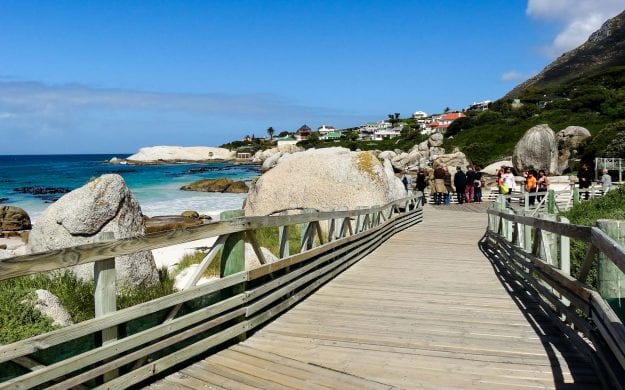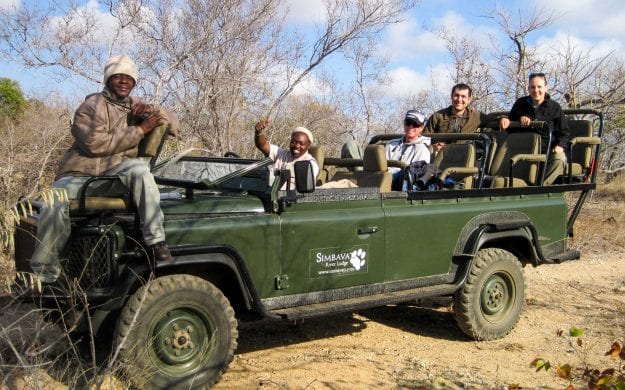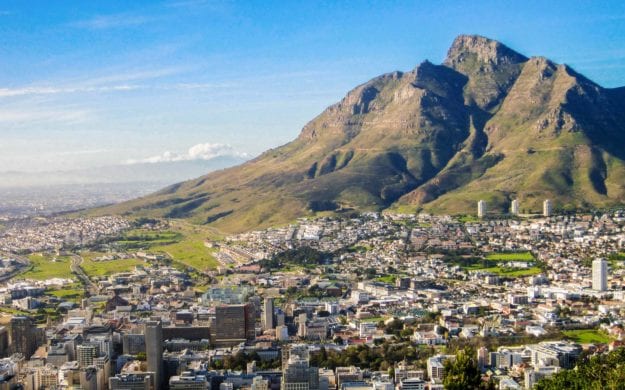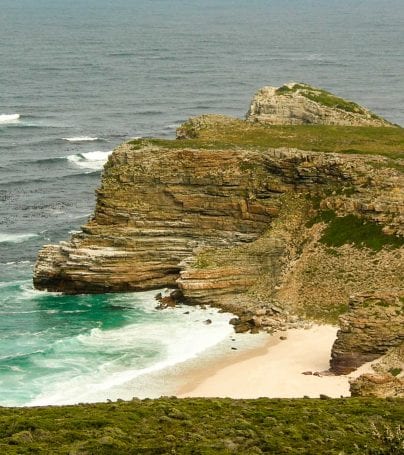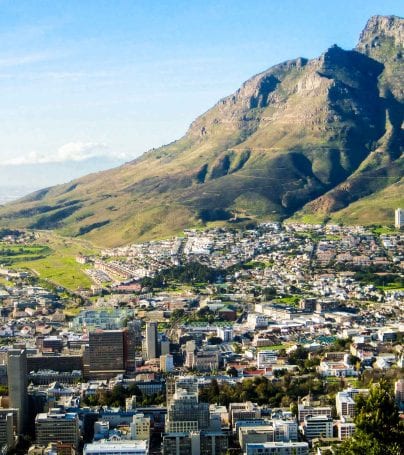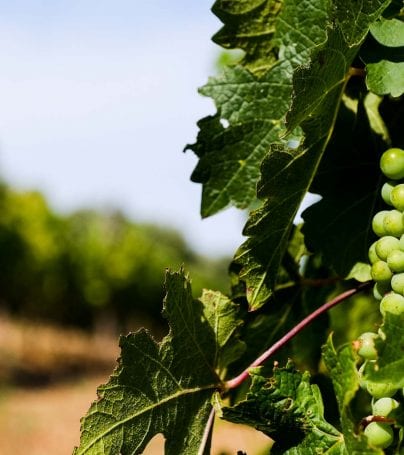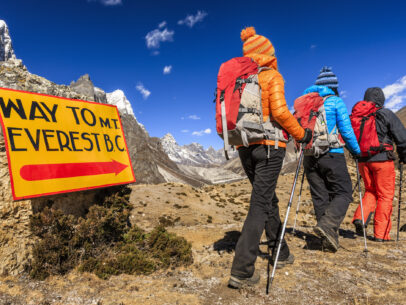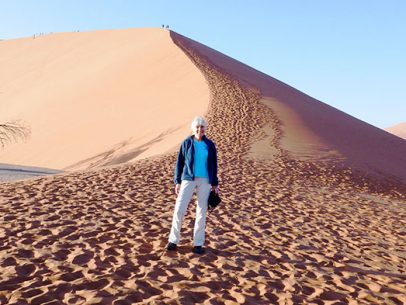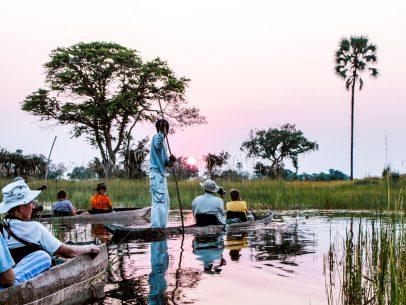Table Mountain Adventure Tours
Table Mountain (Afrikaans: Tafelberg) is a flat-topped mountain forming a prominent landmark overlooking the city of Cape Town in South Africa, and is featured in the Flag of Cape Town and other local government insignia. It is a significant tourist attraction, with many visitors using the cableway or hiking to the top. The mountain forms part of the Table Mountain National Park. The main feature of Table Mountain is the level plateau approximately 3 kilometres (2 mi) from side to side, edged by impressive cliffs. The plateau, flanked by Devil’s Peak to the east and by Lion’s Head to the west, forms a dramatic backdrop to Cape Town. This broad sweep of mountainous heights, together with Signal Hill, forms the natural amphitheatre of the City Bowl and Table Bay harbour. The highest point on Table Mountain is towards the eastern end of the plateau and is marked by Maclear’s Beacon, a stone cairn built in 1865 by Sir Thomas Maclear for trigonometrical survey. It is 1,086 metres (3,563 ft) above sea level, about 19 metres (62 ft) higher than the cable station at the western end of the plateau.
The cliffs of the main plateau are split by Platteklip Gorge (“Flat Stone Gorge”), which provides an easy and direct ascent to the summit and was the route taken by António de Saldanha on the first recorded ascent of the mountain in 1503.
The flat top of the mountain is often covered by orographic clouds, formed when a south-easterly wind is directed up the mountain’s slopes into colder air, where the moisture condenses to form the so-called “table cloth” of cloud. Legend attributes this phenomenon to a smoking contest between the Devil and a local pirate called Van Hunks. When the table cloth is seen, it symbolizes the contest.
Table Mountain is at the northern end of a sandstone mountain range that forms the spine of the Cape Peninsula. To the south of the main plateau is a lower part of the range called the Back Table. On the Atlantic coast of the peninsula, the range is known as the Twelve Apostles. The range continues southwards to Cape Point.
Table Mountain has an unusually rich biodiversity. Its vegetation consists predominantly of several different types of the unique and rich Cape Fynbos. The main vegetation type is endangered Peninsula Sandstone Fynbos, but critically endangered Peninsula Granite Fynbos, Peninsula Shale Renosterveld and Afromontane forest occur in smaller portions on the mountain.
The mountain’s vegetation types form part of the Cape Floral Region protected areas. These protected areas are a World Heritage Site, and an estimated 2,200 species of plants are confined to Table Mountain – more than exist in the whole of the United Kingdom.[8][9] Many of these species, including a great many types of proteas, are endemic to the mountain and can be found nowhere else. In addition, the Table Mountain range has the highest concentration of threatened species of any continental area of equivalent size in the world. Remnant patches of indigenous forest persist in the wetter ravines. However, varieties of fynbos dominate on the more exposed parts of the mountain (such as above the city) where conditions are too dry and harsh for forests. The mountain’s natural wildfire cycle seasonally burns and thus rejuvenates the fynbos vegetation on these exposed slopes.
The mountain has also suffered under a massive onslaught of invasive alien plants for well over a century, with perhaps the worst invader being the cluster pine. Considerable efforts have been made to control the rapid spread of these invasive alien plants.
The most common animal on the mountain is the dassie, or rock hyrax. They especially cluster around the upper cable station, near areas where tourists may discard or (illegally) supply food. There are also porcupines, mongooses, snakes and tortoises. The last lion in the area was shot circa 1802. Leopards persisted on the mountain until perhaps the 1920s but are now extinct locally. Two smaller, secretive, nocturnal carnivores, the rooikat (caracal) and the vaalboskat (also called the vaalkat or African Wild Cat) were once common on the mountain. The rooikat continues to be seen on rare occasions by mountaineers but the status of the vaalboskat is uncertain.
Himalayan tahrs, fugitive descendants of tahrs that escaped from Groote Schuur zoo in 1936, used to be common on the less accessible upper parts of the mountain. As an exotic species, they were almost eradicated through a culling programme initiated by the South African National Parks to make way for the reintroduction of indigenous klipspringers. Until recently there were also small numbers of fallow deer of European origin and sambar deer from southeast Asia. These were mainly in the Rhodes Memorial area but during the 1960s they could be found as far afield as Signal Hill. The animals may by now have been eliminated or relocated.
The Table Mountain Cableway takes passengers from the lower cable station on Tafelberg Road, about 302 m above sea level, to the plateau at the top of the mountain. The upper cable station offers views overlooking Cape Town, Table Bay and Robben Island to the north, and the Atlantic seaboard to the west and south.
Construction of the cableway was first started in 1926, and the cableway was officially opened in 1929. In 1997, the cableway was extensively upgraded, and new cars were introduced carrying 65 instead of 25 passengers. The new cars give a faster journey to the summit, and rotate through 360 degrees during the ascent or descent, giving a panoramic view over the city. The top cable station offers viewpoints, curio shops, a restaurant and walking trails of various lengths.
Hiking on Table Mountain is popular amongst locals and tourists, and a number of trails of varying difficulty are available. Because of the steep cliffs around the summit, direct ascents from the city side are limited. Platteklip Gorge, a prominent gorge up the centre of the main table, is a popular and straightforward direct ascent to the summit. Par for the course is about 2.5 hours but is done between 1–3 hours depending on one’s fitness level.
Longer routes to the summit go via the Back Table, a lower area of Table Mountain to the South of the main plateau. From the Southern Suburbs side, the Nursery Ravine and Skeleton Gorge routes start at Kirstenbosch National Botanical Garden. The route via Skeleton Gorge to Maclear’s Beacon is known as Smuts Track in memory of Jan Smuts, who was a keen hiker. The Bridle Path, or Jeep Track, makes a more gradual ascent from Constantia Nek along the road used to service the dams on Back Table. There are many other paths in popular walking areas on the lower slopes of the mountain accessed from Constantia Nek, Cecilia Park, Kirstenbosch, Newlands Forest and Rhodes Memorial.
On the Atlantic side, the most popular ascent is Kasteelspoort, a gorge overlooking Camps Bay, while the Pipe Track is a level route popular with walkers.
The Hoerikwaggo Trails[19] are four hiking trails on Table Mountain ranging from two to six days, operated by South African National Parks. The original inhabitants of the area, the Khoekhoen and San tribes called Table Mountain Hoerikwaggo – “sea mountain”. The four Table Mountain hiking trails are called the People’s Trail, Table Mountain Trail, Orangekloof Hiking Trail and Top to Tip Trail.
Rock climbing on Table Mountain is a very popular pastime. There are well-documented climbing routes of varying degrees of difficulty up the many faces of the mountain. The main climbs are located on cliffs below the upper cable station. No bolting can be done here and only traditional climbing is allowed. Commercial groups also offer abseiling from the upper cable station.
Most of the world’s important caves occur in limestone but Table Mountain is unusual in having several large cave systems that have developed in sandstone. The biggest systems are the Wynberg Caves, located on the Back Table, not far from the Jeep Track, in ridges overlooking Orange Kloof and Hout Bay.
Customize Your Dream Adventure
We are here to help craft tailor-made adventures for individuals, couples, families, and groups of explorers.

